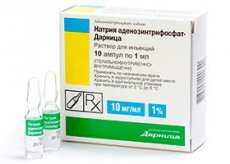Medical expert of the article
New publications
Preparations
Sodium adenosine triphosphate
Last reviewed: 03.07.2025

All iLive content is medically reviewed or fact checked to ensure as much factual accuracy as possible.
We have strict sourcing guidelines and only link to reputable media sites, academic research institutions and, whenever possible, medically peer reviewed studies. Note that the numbers in parentheses ([1], [2], etc.) are clickable links to these studies.
If you feel that any of our content is inaccurate, out-of-date, or otherwise questionable, please select it and press Ctrl + Enter.

Indications Sodium adenosine triphosphate.
It is used in combination with other drugs to help people with muscle atrophy or dystrophy, as well as people with pathologies in which spasms in the area of peripheral vascular organs are observed (this includes Raynaud's syndrome, intermittent claudication, and Buerger's disease).
The drug is also used to prevent the development of paroxysmal supraventricular tachycardia.
The medication, among other things, can also be used to stimulate labor.
The drug ATP-Forte is prescribed to people who have pigment-type degeneration in the retinal area, which is hereditary (central or peripheral, as well as a mixed form of the disease).
Pharmacodynamics
Inside the body, the active component undergoes hydrolysis, resulting in the formation of the ATP element, which is then metabolized to the substance ADP, as well as to an inorganic phosphate due to the interaction that occurs with the element actomyosin. During the metabolism of ATP, energy is released, which is used by the body to perform the processes of binding various components and to perform mechanical functions.
As a result of using LS, there is a decrease in smooth muscle tone, stabilization of the processes of conducting nerve responses within the vegetative nodes, and at the same time, the movement of the excitatory impulse from the vagus nerve to the heart. The metabolism of the ATP element causes weak inhibition of the Purkinje fibers together with the sinus node.
 [ 15 ]
[ 15 ]
Dosing and administration
The drug is administered parenterally. This generally involves intramuscular procedures, but in severe forms of disorders (for example, preventing supraventricular tachyarrhythmia), the solution is administered intravenously. The duration of therapy is prescribed for each patient individually - it is determined by the attending physician.
For adults suffering from muscular dystrophy or problems with peripheral blood flow, intramuscular administration of 1 ml of the solution is often prescribed once a day for 2 days, and then the drug is administered using the same method and in the same dosage, but twice a day. It is allowed to prescribe the administration of 2 ml once a day from the 1st day of the course - in this case, no dosage adjustment will be required in the future.
Such a course often lasts for 30-40 days. If necessary, after 1-2 months from the completion of the previous course, repeated treatment can be prescribed.
People suffering from pigmentary retinal degeneration (of hereditary genesis) should be administered 5 ml of the solution intramuscularly twice a day. The interval between these procedures is about 6-8 hours.
This course generally lasts for 15 days. If necessary, it can be repeated at intervals of 8-12 months.
To prevent supraventricular tachyarrhythmia, an intravenous injection of 1-2 ml of solution is often performed. The entire procedure should last about 5-10 seconds. If the required medicinal effect is not achieved, the solution can be administered again after 2-3 minutes.
Use Sodium adenosine triphosphate. during pregnancy
There is no information on the safety of using the drug by pregnant or lactating women. During pregnancy, it can only be prescribed by the attending physician, taking into account the ratio of the parameters of benefit for the woman and the risk to the fetus.
Contraindications
Main contraindications:
- the presence of severe intolerance to the components of the drug;
- patients experiencing acute myocardial infarction;
- It is prohibited for use in children under 18 years of age, because there is no adequate information about the effectiveness or safety of the solution in this group of patients.
Side effects Sodium adenosine triphosphate.
The drug is often tolerated without complications.
Sometimes, as a result of intramuscular administration of the drug, headaches and tachycardia occur, and in addition, increased diuresis is observed.
As a result of intravenous injection of the drug, vomiting with nausea, headaches, and at the same time hyperemia in the upper half of the body, as well as the face, were sometimes observed.
In addition, signs of allergy can be expected.
If the patient experiences severe side effects, the drug should be discontinued.
Attention!
To simplify the perception of information, this instruction for use of the drug "Sodium adenosine triphosphate" translated and presented in a special form on the basis of the official instructions for medical use of the drug. Before use read the annotation that came directly to medicines.
Description provided for informational purposes and is not a guide to self-healing. The need for this drug, the purpose of the treatment regimen, methods and dose of the drug is determined solely by the attending physician. Self-medication is dangerous for your health.

